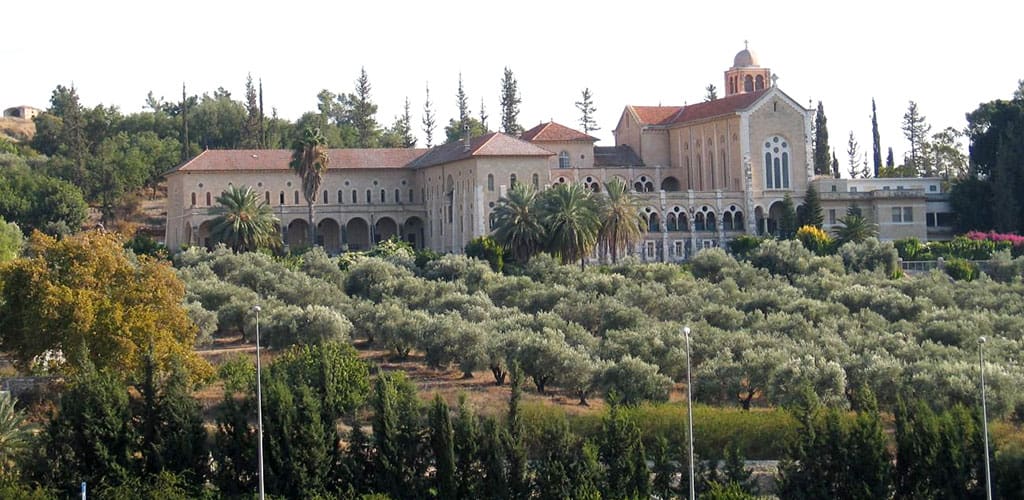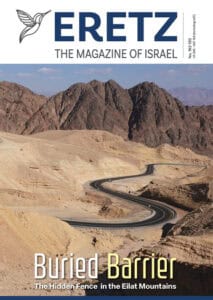
Latrun Fortress
In the middle of the valley, on a hill to the south of the road, stands the British police fort of Latrun. It was built in 1941 as part of a series of similar British fortresses, all known as Taggart Forts after their planner. On the eve of the War of Independence, the British handed the fortress over to the Jordanian Arab League, thus effectively blocking any Jewish approach to Jerusalem. Attempt after attempt of the Israel Defense Forces to capture the fortress and open the road to Jerusalem failed. Finally, a way to build a track that would circumvent the fortress was found. The road through the mountains was called the “Burma Road.” The fortress remained in Jordanian hands until the Six Day War. The site today is a memorial to the Israeli Armored Forces.
Latrun Monastery
On the hill behind the fortress is the Trappist Monastery of Latrun. The monastery was built in 1890 and has vineyards and an extensive farm. The Trappists are sworn to a vow of silence.
Latrun Castle
On the hill above the monastery lie the remains of the Crusader castle of Latrun. The castle was built in 1150 and called “Le Toron des Chevaliers.” The hill on which the castle was built was believed to be the hill where the home village of the good thief, who was crucified with Jesus, once stood. The castle was also known as “Castrum Boni Latronis” – the castle of the good thief.
Getting to Jerusalem is very much a part of your visit to the city. A modern highway, Route 1, leads to Jerusalem from the west – from Tel Aviv and the Ben-Gurion International Airport – and this is the route taken by most visitors to the city today. However, the approach from the west has been the main road to Jerusalem only for the last 200 years. Before that, most travelers arrived at the gates of Jerusalem either from the north or the south, along the ancient Way of the Patriarchs, that ran along the mountain backbone in the center of the country; they also primarily arrived from the east – from the direction of Jericho – which was the main route to Jerusalem from the Galilee and from across the Jordan.
One of the reasons that the approach from the west was never popular was the need to negotiate the relatively steep slopes of the Judean Mountains via one of three narrow defiles that led up the mountain. Many an army fleeing from Jerusalem was ambushed in these narrow defiles and many a traveler was robbed by brigands along the way. The northern and southern ascents – via Beit Horon in the north and via the Valley of Ela in the south (the place where David fought Goliath) – still have remains of the Roman military roads that ran along them. The one in the center, along the Valley of Sha’ar Hagai, is used today by Route 1.
Most people on the road to Jerusalem whiz by the many interesting sites on the way. Following are a few pointers to some of them – to make the best out of the journey into the city.
The Ayalon Valley
Once out of the coastal plain and over the low foothills that run along the foot of the Judean Mountains, the highway curves through a large plain – this is the Ayalon Valley, the place where the sun stood still so that Joshua could complete his victory against the five Amorite kings. The large flat valley has been a battle site for generations. Egyptians, Greeks, Hasmoneans, British, Israelites, and Jordanians have all fought major battles in this valley. At the end of the War of Independence the valley was divided between Israel and Jordan, the exact border running along the edge of the farthest field that each side managed to plow.
Latrun Fortress
In the middle of the valley, on a hill to the south of the road, stands the British police fort of Latrun. It was built in 1941 as part of a series of similar British fortresses, all known as Taggart Forts after their planner. On the eve of the War of Independence, the British handed the fortress over to the Jordanian Arab League, thus effectively blocking any Jewish approach to Jerusalem. Attempt after attempt of the Israel Defense Forces to capture the fortress and open the road to Jerusalem failed. Finally, a way to build a track that would circumvent the fortress was found. The road through the mountains was called the “Burma Road.” The fortress remained in Jordanian hands until the Six Day War. The site today is a memorial to the Israeli Armored Forces.
Latrun Monastery
On the hill behind the fortress is the Trappist Monastery of Latrun. The monastery was built in 1890 and has vineyards and an extensive farm. The Trappists are sworn to a vow of silence.
Latrun Castle
On the hill above the monastery lie the remains of the Crusader castle of Latrun. The castle was built in 1150 and called “Le Toron des Chevaliers.” The hill on which the castle was built was believed to be the hill where the home village of the good thief, who was crucified with Jesus, once stood. The castle was also known as “Castrum Boni Latronis” – the castle of the good thief.


